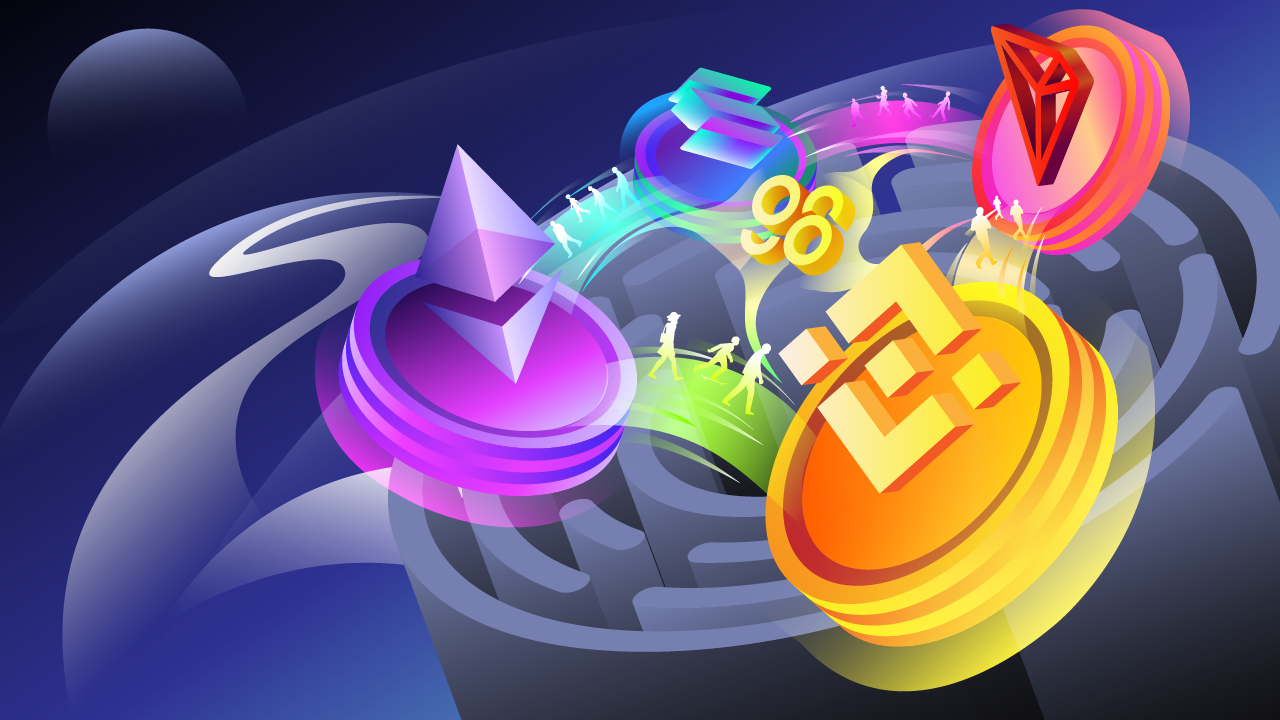What if the future of decentralized finance (DeFi) no longer depended on a single blockchain? How cross-chain bridges unlock liquidity between Ethereum and Solana is crucial to understanding the next phase of this evolution.
In the rapidly evolving landscape of digital finance, Ethereum and Solana have emerged as two leading blockchain networks, each boasting distinct advantages.
Ethereum is renowned for its robust and established DeFi ecosystem, hosting a multitude of decentralized applications and services. In contrast, Solana offers high-speed, low-cost transactions, attracting developers and users seeking efficiency and scalability.
In this article, we will explore how cross-chain bridges unlock liquidity between Ethereum and Solana, paving the way for a more integrated and dynamic DeFi landscape.
- 1 What Are Cross-Chain Bridges?
- 2 Reasons Why Ethereum and Solana Need Cross-Chain Bridges
- 3 Key Cross-Chain Bridges Connecting Ethereum and Solana
- 4 How Cross-Chain Bridges Unlock Liquidity Between Ethereum and Solana
- 5 Conclusion
-
6
FAQ
- 6.1 1. What is a cross-chain bridge?
- 6.2 2. Is there a bridge between Solana and Ethereum?
- 6.3 3. How to bridge base ETH to Solana?
- 6.4 4. How to bridge ERC20 to SOL?
- 6.5 5. How to bridge from ETH to SOL on Phantom?
- 6.6 6. How do cross-chain bridges connect Ethereum and Solana?
- 6.7 7. What are the risks of using cross-chain bridges?
- 6.8 8. Which are the best cross-chain bridges for Ethereum and Solana?
- 6.9 9. Can I transfer NFTs using cross-chain bridges?
What Are Cross-Chain Bridges?
Definition: Cross-chain bridges are decentralized protocols that enable the transfer of assets, data, and liquidity between two or more blockchain networks.
These bridges function by establishing a connection that allows users to move digital assets across different ecosystems seamlessly, addressing the challenges of liquidity fragmentation.
Understanding how cross-chain bridges unlock liquidity between Ethereum and Solana is essential for grasping their importance in the DeFi space.
Analogy: Think of cross-chain bridges as highways connecting different cities. Just as highways allow for the free movement of vehicles and people, cross-chain bridges facilitate the movement of digital assets across otherwise isolated blockchain ecosystems.
This connectivity is vital for enhancing the overall functionality and accessibility of decentralized finance.
Types of Cross-Chain Bridges: There are several types of cross-chain bridges, each serving different purposes. Common examples include:
- Two-Way Pegs: These bridges lock assets on one blockchain and allow for the creation of equivalent tokens on another, enabling easy transfer back and forth.
- Wrapped Tokens: A popular method where tokens from one blockchain are locked in a smart contract, and a corresponding “wrapped” version is minted on another blockchain, making it usable within that ecosystem.
- Oracles: These are decentralized systems that facilitate the transfer of data and information across chains, ensuring that all connected ecosystems have access to the same data for seamless operations.
How It Works: Moving assets from one chain to another using cross-chain bridges is straightforward.
Users lock their tokens on the original blockchain, effectively rendering them inaccessible for the duration of the transfer. In return, an equivalent amount of tokens is minted on the target blockchain, often called wrapped tokens.
This method ensures that the total supply of the asset remains consistent across both chains, preventing double-spending.
This mechanism exemplifies how cross-chain bridges unlock liquidity between Ethereum and Solana, enabling users to capitalize on each blockchain’s unique advantages.
Reasons Why Ethereum and Solana Need Cross-Chain Bridges
Ethereum’s Liquidity Dominance
Commanding a sizable portion of distributed liquidity via well-known platforms like Uniswap, Aave, and MakerDAO, Ethereum is the biggest distributed finance (DeFi) platform.
Ethereum’s vast ecosystem presents unmatched chances for traders, investors, and engineers given billions of money locked in smart contracts.
Knowing how cross-chain bridges unlock liquidity between Ethereum and Solana emphasizes, nonetheless, the need of both ecosystems working together and efficiently sharing resources.
Solana’s Speed and Scalability
Solana appeals to distributed apps (dApps) because of its outstanding transaction speeds and shockingly low fees.
Solana currently has the same degree of liquidity than Ethereum, even if its technological capacity places it nicely for high throughput and efficiency.
This disparity reduces the possibility for dApps developed on Solana to leverage the huge liquidity pools Ethereum offers.
The Fragmentation Problem
Lack of natural compatibility between Ethereum and Solana has resulted in liquidity silos impeding the expansion of distributed finance (DeFi).
Every blockchain runs separately, leading to a fragmented market where users cannot readily migrate assets between ecosystems.
This fragmentation limits the capacity to use the advantages of both platforms and stifles innovation all throughout the DeFi terrain.
Value Proposition of Bridges
Unlocking trapped liquidity and giving consumers access to the best of both worlds, cross-chain bridges present a solution.
Bridges let users access Ethereum’s vast liquidity pool while still enjoying Solana’s speed and low transaction costs by letting assets move naturally between Ethereum and Solana.
This dynamic improves user experience and drives expansion for both platforms, hence fostering a more integrated DeFi ecosystem.
Key Cross-Chain Bridges Connecting Ethereum and Solana
1. Wormhole Bridge:
Wormhole is a prominent cross-chain bridge that enables bidirectional transfers between Ethereum and Solana.
This innovative protocol facilitates the movement of assets, allowing users to leverage the advantages of both blockchains.
By understanding how cross-chain bridges unlock liquidity between Ethereum and Solana, it becomes clear that Wormhole plays a crucial role in enhancing interoperability in the DeFi ecosystem.
Features: Wormhole boasts low latency and decentralized governance, making it a reliable option for users. Its broad support for various assets ensures that a wide range of tokens can be easily transferred between Ethereum and Solana, facilitating increased liquidity.
Use Cases: The Wormhole bridge enhances liquidity movement in various DeFi applications and NFT marketplaces. For instance, users can easily transfer tokens to participate in liquidity pools or trade NFTs across different platforms, broadening their access to diverse markets.
2. Allbridge:
Allbridge is another significant player in the cross-chain bridge space, supporting interoperability between Ethereum, Solana, and several other blockchains.
This platform simplifies the user experience while enabling seamless asset transfers and swaps.
Features: Allbridge focuses on simplicity, making it user-friendly for both beginners and experienced traders. The platform facilitates cross-chain swaps, allowing users to exchange assets without the need for complex procedures.
3. Portal:
Portal is a cross-chain bridge that provides secure asset transfers between Ethereum and Solana, focusing on decentralized finance solutions.
Features: It prioritizes security through a decentralized framework, ensuring that users can safely move their assets without the risk of central points of failure.
Use Cases: Portal is particularly useful for liquidity providers who want to take advantage of Solana’s fast transaction speeds while accessing Ethereum’s extensive liquidity pools.
4. RenBridge:
RenBridge facilitates the transfer of assets between Ethereum and Solana using the RenVM protocol, which enhances cross-chain capabilities.
Features: RenBridge allows for seamless asset wrapping and unwrapping, ensuring that users can easily convert their tokens for use across different networks.
Use Cases: This bridge is popular among users who engage in arbitrage opportunities, taking advantage of price discrepancies across platforms by quickly moving assets between chains.
5. Synapse Protocol:
Synapse Protocol is another key player that enables cross-chain asset transfers, including between Ethereum and Solana, focusing on providing liquidity across multiple chains.
Features: It offers low fees and fast transaction speeds, making it an attractive option for users looking to quickly swap assets across networks.
Use Cases: Synapse is especially beneficial for traders and liquidity providers who want to access various liquidity pools and maximize their investment opportunities across different ecosystems.
How Cross-Chain Bridges Unlock Liquidity Between Ethereum and Solana
Cross-chain bridges are instrumental in how cross-chain bridges unlock liquidity between Ethereum and Solana, facilitating the seamless movement of assets between these two powerful ecosystems.
This process allows users to access the benefits of both networks without being limited by the inherent constraints of each blockchain.
1. Liquidity Movement:
The process of moving liquidity from Ethereum to Solana via a bridge is straightforward yet powerful. For example, consider a user wanting to move USDT (Tether) from Ethereum to Solana using the Wormhole bridge.
The user initiates the transfer by locking their USDT on the Ethereum blockchain, which creates a representation of that asset on Solana, often referred to as a “wrapped” token. This allows the user to operate within the Solana ecosystem while maintaining the underlying value of their assets.
2. Increase in DeFi Efficiency:
Unlocking liquidity through cross-chain bridges enables more efficient decentralized finance (DeFi) strategies.
For instance, with access to liquidity from both Ethereum and Solana, users can engage in arbitrage opportunities, where they take advantage of price discrepancies for the same asset across different platforms.
This not only enhances trading strategies but also stabilizes prices across the two networks, contributing to overall market efficiency.
3. Capital Efficiency:
Cross-chain bridges significantly improve capital efficiency by reducing the need for users to duplicate their capital across chains. Instead of holding assets on both Ethereum and Solana, users can utilize bridges to move their liquidity as needed.
This enables them to maximize returns, as they can deploy their capital more effectively, allowing liquidity to work across multiple blockchains and reducing idle assets.
4. Boost to DApps and DeFi Protocols:
Bridges also play a crucial role in enabling decentralized applications (DApps) and DeFi protocols on Ethereum and Solana to tap into each other’s liquidity pools.
By facilitating the flow of assets, these bridges create more robust markets, allowing users to benefit from a broader range of financial products and services.
As a result, the overall DeFi ecosystem becomes more interconnected, fostering innovation and growth.
Conclusion
In summary, how cross-chain bridges unlock liquidity between Ethereum and Solana is a game-changing aspect of the decentralized finance landscape.
These bridges facilitate the seamless transfer of assets, allowing users to leverage the unique strengths of both ecosystems.
By providing a pathway for liquidity movement, cross-chain bridges enhance trading efficiency, capital utilization, and the overall robustness of the DeFi market.
As you navigate the evolving world of decentralized finance, we encourage you to explore cross-chain bridges to optimize your DeFi strategies.
By taking advantage of the liquidity opportunities between Ethereum and Solana, you can position yourself to benefit from the best of both networks, whether you are trading, providing liquidity, or engaging with innovative DApps.
Looking ahead, it is clear that cross-chain bridges will play a pivotal role in shaping the future of decentralized finance.
As more users and developers recognize the potential of these technologies, we can expect a more interconnected and efficient DeFi ecosystem that will drive innovation and growth across all blockchain networks.
Embrace the possibilities that lie ahead, and consider how cross-chain solutions can enhance your participation in this dynamic space.
FAQ
1. What is a cross-chain bridge?
A cross-chain bridge is a technology that enables the transfer of assets and data between different blockchain networks, facilitating interoperability. This is crucial in how cross-chain bridges unlock liquidity between Ethereum and Solana, allowing users to access and utilize resources across both platforms.
2. Is there a bridge between Solana and Ethereum?
Yes, several bridges facilitate the transfer of assets between Solana and Ethereum. Notably, the Wormhole bridge is one of the most popular solutions, effectively enabling users to move tokens and liquidity across these two ecosystems.
3. How to bridge base ETH to Solana?
To bridge base ETH to Solana, you can use a cross-chain bridge like Wormhole. The process involves locking your ETH on Ethereum and receiving a wrapped version on Solana, allowing you to utilize your assets in the Solana ecosystem.
4. How to bridge ERC20 to SOL?
Bridging ERC20 tokens to SOL involves using a bridge that supports ERC20 assets, such as Wormhole or Allbridge. Simply follow the instructions on the bridge platform to lock your ERC20 tokens on Ethereum and mint them on Solana.
5. How to bridge from ETH to SOL on Phantom?
To bridge from ETH to SOL using the Phantom wallet, connect your wallet to a supported bridge, like Wormhole, and follow the on-screen instructions to initiate the transfer, ensuring you have sufficient gas fees for the transaction.
6. How do cross-chain bridges connect Ethereum and Solana?
Cross-chain bridges connect Ethereum and Solana by allowing users to lock their assets on one chain and mint corresponding tokens on the other. This process creates an interconnected ecosystem that enhances liquidity flow and user experience.
7. What are the risks of using cross-chain bridges?
While cross-chain bridges provide significant benefits, they come with risks, including smart contract vulnerabilities, potential hacks, and reliance on third-party services. Users should conduct thorough research and exercise caution when using these bridges.
8. Which are the best cross-chain bridges for Ethereum and Solana?
Some of the best cross-chain bridges for connecting Ethereum and Solana include Wormhole, Allbridge, and Portal. Each bridge has unique features and capabilities, so users should choose based on their specific needs and preferences.
9. Can I transfer NFTs using cross-chain bridges?
Yes, you can transfer NFTs between Ethereum and Solana using cross-chain bridges that support non-fungible tokens. This enables users to access diverse marketplaces and communities across both blockchain ecosystems.



